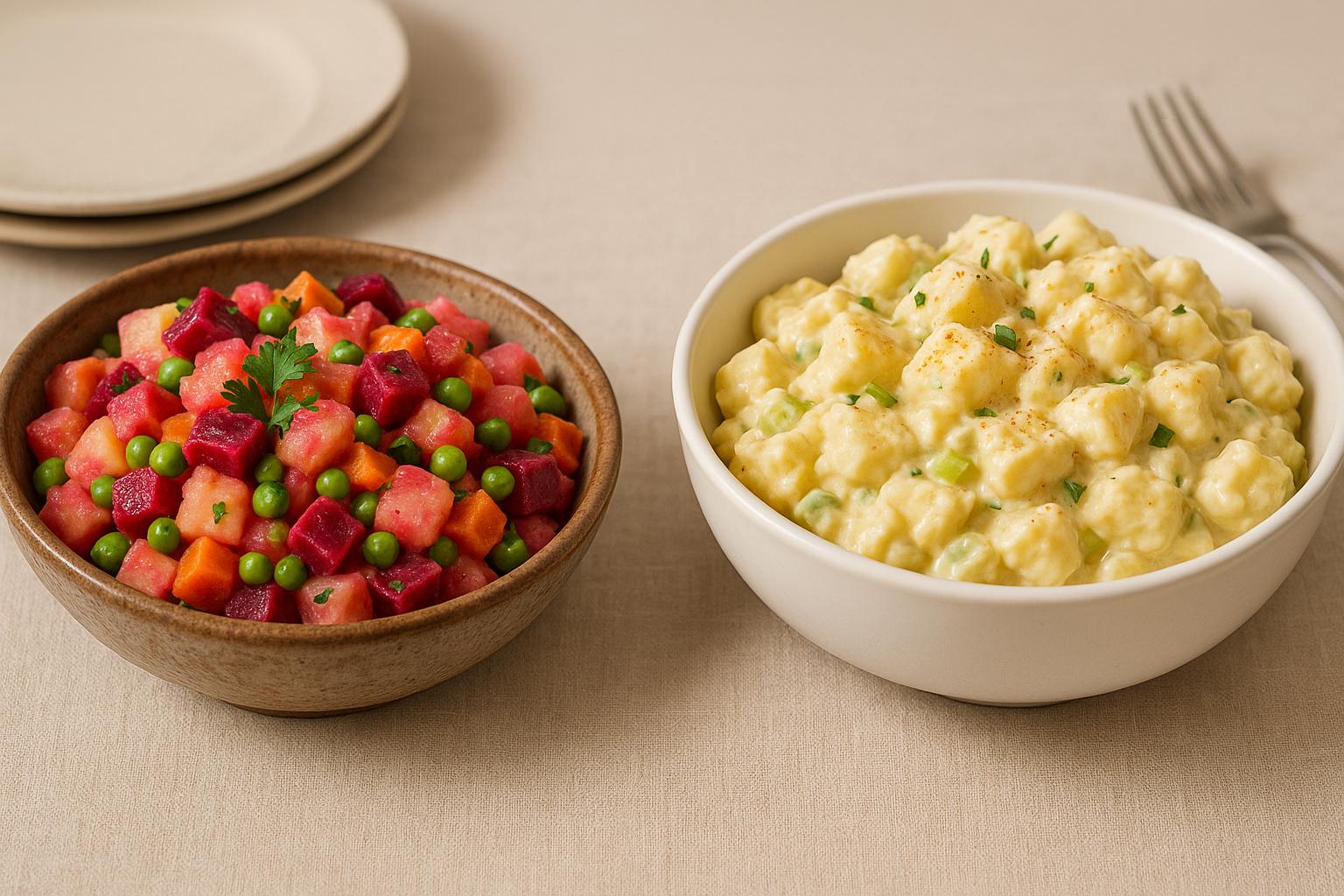Poul Nan Sos, or Haitian Chicken Stew, is a flavorful dish that combines seared chicken with a rich, spiced tomato-based sauce. It's a staple in Haitian kitchens, often served with rice, beans, or plantains. The key to its bold taste lies in the Epis seasoning, a blend of garlic, onions, peppers, and herbs. Here's a quick breakdown:
- Main Ingredients: Chicken, tomato paste, diced tomatoes, chicken stock, fresh herbs, and Epis seasoning.
- Preparation: Clean and marinate the chicken with citrus and Epis. Let it sit for at least 30 minutes or overnight for deeper flavor.
- Cooking: Sear the chicken, sauté aromatics, and simmer with the sauce until tender.
- Serving: Pair with rice, beans, plantains, or bulgur for a complete meal.
- Storage: Refrigerate leftovers for up to 4 days or freeze for 3 months.
This dish is perfect for gatherings or weeknight dinners, offering a taste of Haitian comfort food with every bite.
Ingredients and Tools You'll Need
Main Ingredients for Poul Nan Sos
To make an authentic Poul Nan Sos, you'll need fresh chicken and traditional Haitian seasonings. Start with 3–4 lbs of chicken, cut into pieces. A whole chicken works great, but thighs and drumsticks are also excellent for flavor.
For the Epis base, gather 6–8 garlic cloves, 2 medium onions, 2 bell peppers, and 4–5 scallions. If you like heat, include Scotch bonnet peppers. Can't find them? Substitute with 2 tablespoons of hot sauce or habanero chiles.
To create the rich, signature sauce, use tube tomato paste (great for avoiding waste) and a 14.5‑oz can of diced tomatoes. Add 2–3 cups of chicken stock and a few sprigs of fresh thyme for a flavorful foundation.
Seasonings are key. You'll need Cajun seasoning, or if unavailable, a mix of kosher salt and black pepper will do. Other essentials include bay leaves, lime or lemon juice, and vegetable oil for browning the chicken. For the vegetables, you can use traditional Haitian root vegetables like yellow yam, cassava, or taro. If these are hard to find, russet or Yukon Gold potatoes, or even Japanese sweet potatoes, are great substitutes. Similarly, swap watercress with spinach, kale, collard greens, or Swiss chard.
If making Epis from scratch isn’t an option, you can use a table spice mix or an all-purpose seasoning blend (MSG-free). While the flavor will differ slightly, it’s still a solid alternative.
Once your ingredients are prepped, make sure your kitchen tools are ready to simplify the cooking process.
Kitchen Tools and Equipment
Start with sharp knives or kitchen shears for cutting chicken and chopping vegetables. A sturdy cutting board is essential for safe and efficient prep.
You'll need a large bowl for cleaning, marinating, and mixing seasonings. A colander is perfect for rinsing the chicken, and paper towels are handy for drying it before seasoning and browning.
For the Epis, use a food processor or blender to achieve a smooth consistency. If you prefer a more traditional approach, a mortar and pestle (pilon) works too, though it requires a bit more effort.
When it’s time to cook, reach for a heavy-bottomed pot or Dutch oven - large enough to hold all the chicken pieces in a single layer for proper browning. Keep a wooden spoon, ladle, and measuring cups/spoons nearby for easy handling.
With these ingredients and tools, you’ll be ready to bring this classic Haitian dish to life in your own kitchen.
How to Make Poul Nan Sos
Preparing and Marinating the Chicken
The journey to a flavorful Poul Nan Sos starts with properly cleaning your chicken. Begin by trimming off visible fat, blood vessels, and any impurities. Make small slits in the meat to ensure it absorbs the seasoning deeply [1].
Next, rub the chicken with lime juice, sour orange, or distilled vinegar. This not only cleans the meat but also tenderizes it while adding a hint of tanginess [1]. Rinse the chicken thoroughly with warm water, and then give it what Haitian cooks call a "hot bath" - pour boiling water over the pieces and let them sit for 20 seconds to 2 minutes. This step further cleans and preps the meat [1].
Once cleaned, pat the chicken dry and generously coat it with Epis and salt. Don’t discard the marinade - save it for later to enhance the dish’s flavor. Let the chicken marinate for at least 30 minutes, or leave it overnight for a deeper infusion of flavor [1].
Making the Epis Seasoning Base
For a truly authentic taste, traditional Haitian cooks crush garlic with a mortar and pestle instead of chopping it. This method releases more oils and juices, creating a rich flavor base for the stew [1].
Combine the crushed garlic with the other Epis ingredients - onions, bell peppers, scallions, and your choice of hot peppers. If you’re using Scotch bonnet peppers, expect a heat level between 100,000 and 350,000 Scoville units along with sweet, citrusy undertones, which differ slightly from the sharper heat of habaneros [2]. Blend or process the ingredients until they form a smooth, paste-like consistency.
This aromatic paste will be the heart of your stew.
Cooking the Stew
With the chicken marinated and the Epis ready, it’s time to start cooking. Heat oil in a heavy-bottomed pot or Dutch oven over medium-high heat. Sear the marinated chicken pieces in batches to avoid overcrowding, cooking them until they develop a golden-brown crust on both sides [1].
Remove the browned chicken and set it aside. In the same pot, sauté diced onions and crushed garlic for about 45 seconds [1]. Stir in tomato paste and sliced bell peppers, cooking until the tomato paste deepens in color - this should take around 3 minutes [1][2].
Deglaze the pot with ¼ of the reserved marinade, scraping up any browned bits stuck to the bottom. Add the chicken back to the pot, along with the remaining marinade, chicken stock, citrus juice, apple cider vinegar, and fresh herbs [1][2]. Spoon some of the onion mixture over the chicken to give it that signature reddish hue [1].
Bring the stew to a boil, then cover and reduce the heat to medium. Let it simmer for 15–20 minutes. Afterward, lower the heat to a gentle simmer and uncover the pot. Add any remaining sliced onions, adjust the seasoning, and cook for another 5–10 minutes until the chicken is tender and the sauce has thickened slightly [1][2].
If you’re using chicken breast, be sure to remove it after about 30–35 minutes to prevent it from drying out. Thighs and legs, however, can cook longer until they’re perfectly tender [3]. For an oven-cooked version, baste the chicken every 15 minutes to coat it evenly with the sauce and peppers [2].
Tips for Better Flavor and Recipe Variations
How to Improve the Flavor
Making Poul Nan Sos is all about patience and layering flavors that reflect Haitian culinary traditions. While marinating for 30 minutes is fine, letting the Epis work its magic overnight allows the seasoning to deeply infuse the meat, resulting in richer, more developed flavors.
Fresh herbs can make a big difference here. Adding fresh thyme during the simmering process and finishing with chopped parsley just before serving keeps their flavors vibrant and aromatic. These small touches can elevate the dish's overall taste.
Keep the heat low once the stew starts simmering. This helps tenderize the chicken while naturally thickening the sauce without introducing any bitterness. A splash of citrus juice or apple cider vinegar adds a subtle brightness, balancing the flavors and helping to tenderize the meat. Start with a little and adjust as needed - acidity is your friend, but too much can overpower the dish.
Finally, don’t skip the browning step. Properly browning the chicken at the start builds a deep, savory base for the stew. These techniques not only enhance the flavor but also make it easier to adapt the recipe to your preferences.
Regional and Household Variations
Haitian families often put their own spin on Poul Nan Sos, continuing the tradition of personalized family recipes. For example, some cooks like to add coconut milk, which gives the sauce a creamy texture. Others include root vegetables like carrots or turnips, adding a hint of natural sweetness that balances the savory flavors of the dish.
When it comes to heat, Scotch bonnet peppers are the go-to choice for their bold, spicy kick. However, if you prefer milder flavors, you can substitute with less intense peppers while still keeping the dish flavorful. Some households also simplify the process by using store-bought sofrito as a base for the Epis, then enhancing it with extra garlic, fresh herbs, and peppers for a more customized flavor.
Stovetop vs. Slow Cooker Methods
The cooking method you choose can significantly influence the final dish. Here’s a quick comparison of stovetop and slow cooker approaches:
| Aspect | Stovetop Method | Slow Cooker Method |
|---|---|---|
| Cooking Time | 45–60 minutes of active cooking | 4–6 hours on low or 2–3 hours on high |
| Flavor Development | Browning creates deeper, richer flavors | Gentle cooking preserves herbaceous notes |
| Texture Control | Better control over sauce thickness | Meat becomes extra tender but less control over sauce consistency |
| Convenience | Requires active attention | A "set-it-and-forget-it" option |
| Energy Usage | Higher heat for a shorter time | Lower energy use over a longer duration |
The stovetop method shines when it comes to developing bold, caramelized flavors and achieving perfect sauce consistency. On the other hand, the slow cooker is a lifesaver on busy days, delivering tender, fall-apart chicken with minimal effort. If you go the slow cooker route, consider browning the chicken in a skillet first to enhance the flavor. Also, reduce the liquid by about 25% since there’s less evaporation during slow cooking. To keep delicate vegetables like bell peppers from getting mushy, add them during the last hour of cooking.
Both methods have their strengths, so choose the one that best suits your schedule and flavor preferences.
sbb-itb-80c33ff
Serving and Storage
What to Serve with Poul Nan Sos
Poul Nan Sos shines when paired with traditional sides that soak up its rich, hearty sauce. Popular choices include white rice, rice and beans, boiled or fried plantains, cornmeal, bulgur, or rice with black mushrooms [1][4].
"Traditionally this stew is best enjoyed with red beans and rice, white rice, corn meal, boiled plantains, or bulgur (Ble)." – Savory Thoughts [1]
"You definitely need a bed of rice or something to help soak up all of the liquid (we served with a side of rice and beans)." – Accounting for Taste [4]
Here’s why these sides work so well:
- White rice: A simple, neutral base that highlights the stew's bold flavors.
- Rice and beans (diri ak pwa): Adds protein for a more satisfying meal.
- Plantains: Fried plantains (Bannann Peze) offer a crispy contrast, while boiled plantains provide a softer, sweeter touch.
- Cornmeal (mayi moulen): Often served with black bean purée (sos pwa) and avocado slices for a balanced plate.
- Bulgur (Ble): Absorbs the stew’s flavors and adds a nutty undertone.
- Rice with black mushrooms (diri ak djon djon): A special-occasion side that complements the stew’s robust taste perfectly.
Once you’ve enjoyed your meal, storing and reheating leftovers is simple with the right techniques.
Storage and Reheating Guidelines
To keep Poul Nan Sos fresh, follow these storage tips: refrigerate for up to 4 days or freeze for up to 3 months.
Cooling and Storing:
Allow the stew to cool completely before transferring it to an airtight container. This should be done within two hours of cooking to avoid bacterial growth [5].
Refrigeration:
Leftovers can be stored in the fridge for up to 4 days. In fact, the flavors often deepen and improve after a day or two [1].
Freezing:
For longer storage, place the cooled stew in freezer-safe containers. Remove as much air as possible to prevent freezer burn. Properly stored, it will stay good for up to 3 months [5].
Reheating Tips:
- From the Refrigerator: Heat in a pan over medium heat, stirring occasionally until warmed through [7].
- From the Freezer: Thaw overnight in the refrigerator [6]. Then, reheat in a Dutch oven or saucepan over low to medium-low heat, adding a bit of water to prevent sticking and covering with a lid [6].
- Microwave: Use a lower power setting and stir frequently to ensure even heating. Arrange meat on top for better heat distribution [7].
- Double Boiler: For a gentler reheating option, use a double boiler to warm the stew evenly without scorching [6].
After reheating, give it a taste and adjust the seasonings if needed [6]. Following these steps ensures your leftovers are just as delicious as the first serving!
How To Make Haitian Chicken Stew | Sòs Poul Recette | Haitian Chicken Sauce Recipe
Conclusion
Bringing Poul Nan Sos into your kitchen means more than just making a meal - it’s about experiencing a slice of Haitian comfort. With its rich, savory sauce and tender chicken, this dish is a true crowd-pleaser. But its charm lies not only in its ingredients but also in the way it’s prepared.
Whether you simmer it on the stovetop or let it slowly cook, the result is a flavorful masterpiece. The key? The magic of epis and the slow, thoughtful layering of flavors.
Once you master this stew, you’ll understand why it holds such a special place in Haitian homes. Plus, the flavors only deepen over time, making leftovers just as delightful as the first serving.
Ready to dive deeper into Haitian cuisine? Check out HaitianFoods.org for more recipes and traditions. From timeless classics to fresh takes, there’s always something delicious waiting to be explored.
FAQs
Why is Epis seasoning important in Haitian Chicken Stew, and can you use a substitute?
Epis seasoning is the soul of Haitian Chicken Stew, infusing it with bold, unforgettable flavors. This vibrant blend of fresh herbs, garlic, peppers, and citrus forms a rich, aromatic base that captures the heart of Haitian cooking. It’s more than just a seasoning - it’s a cherished tradition, passed down through generations.
While you might consider substituting it with a mix of garlic, parsley, thyme, and vinegar, these alternatives can’t quite match the depth or character of authentic Epis. For a truly genuine flavor, there’s no substitute for making Epis from scratch.
How can I make sure the chicken stays tender and flavorful when cooking Haitian chicken stew?
To keep your chicken tender and packed with flavor, begin by marinating it for at least 30 minutes. This step allows the meat to soak up delicious flavors while staying juicy. When you start cooking, let the chicken release its natural juices before adding any water. As it nears being fully cooked, reduce the heat to low and let it simmer for about 40 minutes or until it's perfectly tender. Add small amounts of water as needed to keep it from drying out. Keeping the pot covered during cooking helps trap moisture, ensuring your chicken stays juicy and flavorful.
How can I adjust the heat level of Haitian Chicken Stew (Poul Nan Sos) to suit my taste?
To tweak the spice level of Poul Nan Sos, simply adjust the quantity of hot peppers. Want it extra spicy? Toss in more Scotch Bonnet or Habanero peppers. Prefer something milder? Cut back on the hot peppers or skip them altogether. For a balanced flavor with less heat, try adding ingredients like bell peppers or fresh herbs to keep it tasty but gentler on the palate.


